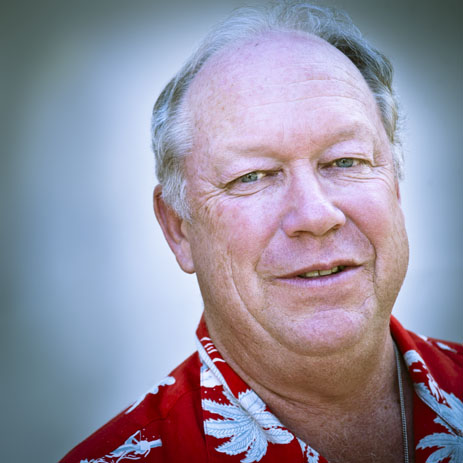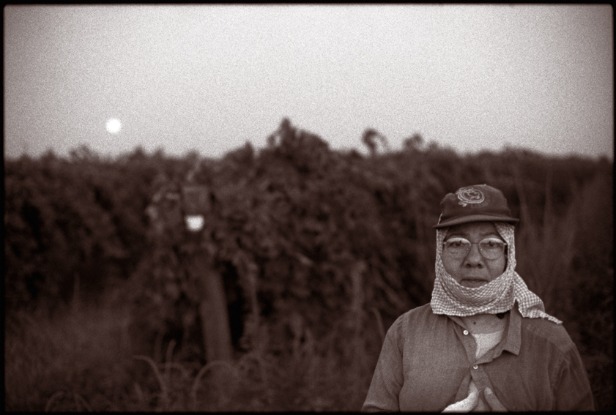 Bob Scowcroft in 2008, in one of his signature shirts.Photo: Bart NagelAfter nearly three decades at the center of organic food and farming world, Bob Scowcroft recently retired as head of the Organic Farming Research Foundation (OFRF). Scowcroft was California Certified Organic Farmers‘ first executive director in 1987, then went on to cofound and lead the OFRF for two decades. OFRF has played a key role on two fronts — advocating for organic farming research and pushing for a state, and then national, organic law.
Bob Scowcroft in 2008, in one of his signature shirts.Photo: Bart NagelAfter nearly three decades at the center of organic food and farming world, Bob Scowcroft recently retired as head of the Organic Farming Research Foundation (OFRF). Scowcroft was California Certified Organic Farmers‘ first executive director in 1987, then went on to cofound and lead the OFRF for two decades. OFRF has played a key role on two fronts — advocating for organic farming research and pushing for a state, and then national, organic law.
With his penchant for bear hugs and loud Hawaiian shirts, and the sharp insights and confabs, like the Organic Summits he founded, Scowcroft is the organic world’s preeminent “connector.” He has street cred with everyone from Midwestern wheat farmers to CEOs from organic food companies — both of whom could be found at OFRF’s fundraisers, which were fueled by good food and wine.
Here, Scowcroft chats about the beginning of the organic movement and the “new blood” he’s excited about — yours.
Q. Now that organic farming’s been codified into a set of regulations, some people complain it allows too many exceptions. What do you think of such criticisms?
A. I think we should approach organic with the concept of continuous improvement. If you take that approach, then we should celebrate critiques that help us improve our system. They’re critical to our evolution. But if they’re delivered in the form of hate speech — “I will bring it all down before I’ll let it go forward” — that deserves the public condemnation it gets.
With the arrival of a new generation of organic activists, the personalities largely will become less important, and collaboration will become more important. I am actually most hopeful, if not utterly blown away, by the new youth movement in organic.
Q. So, as a member of the first generation of organic advocates, you’re now passing the torch?
A. Well, I’m really second generation. The first was J.I. Rodale, the folks at Walnut Acres, many others. I feel my generation, the second generation, took the organic vision and put it into practice. We showed that it could be done commercially.
Now we need to step aside. We’ve got to get out of the way for the 35- and 40-year-olds — the ones that Tweet organic research results, who understand organizing issues through Facebook. And who can lay out the five or 10 steps we need to take to get organic from 4 percent to 40 percent of the food system.
It took 30 years, I think, to get from .013 percent to 4 percent. Now we have to go to 40 percent. What’s it going to take?
Q. You think that’s realistic?
A. Yes. Actually, I think it’s a necessity. I think it’s urgent. How much longer is the soil going to run down the Mississippi? Think about how riveted we all were the oil pouring into the Gulf. You felt it, you saw it, you were hurt by it. But its size was only a third of the dead zone, which is there every year!
I think we’re facing a new level of urgency about our food system but hardly anyone in a position of authority is connecting the dots. We have an administration that’s more aware of this than most, but it can’t move on any one issue without tripping over a vested interest. That’s why this movement — led by the next generation — is vital.
Q. Let’s go back to the beginning, to California Certified Organic Farmers (CCOF), which is now a major certification organization. How’d you get involved with them?
A. I met CCOF through working at Friends of the Earth, which was fighting chemicals. At the time I was trying to ban two of them, 2,4,5-T and 2,4-D, which together comprise Agent Orange. And there was always another chemical to fight. One day a farmer found me, an incredibly wonderful cranky guy who’s since passed away, Sy Weisman, one of the founders of CCOF, and he said, “Why are you doing this? Get off the grid! You’re not gonna ban ‘em all! Be in favor of something good!”
Q. He said to push for an alternative?
A. Yes, he was saying, “You’re never going to succeed at this [banning thousands of toxic chemicals.] You should just be in favor of organic. It’s good! Be positive! All you environmentalists are against everything.”
So I joined CCOF as the director when it had regional chapters in the state, many doing their own thing. A bare majority of farmers wanted to make it a statewide group, to have one standard for all 12 chapters, so everyone would follow the same rules. A majority also wanted to professionalize the inspection and certification process. By then, it was clear that visiting your farm, having a cup of tea, looking in your backyard, and talking soil fertility wasn’t going to cut it anymore for certification. Eventually, our standards — ours and others — became the backbone of what is now the national organic law. In two and a half years, we grew from 170 to 740 farmers.
Q. How did you come to start the Organic Farming Research Foundation?
A. OFRF was an offshoot of CCOF. In 1990, we needed funding to balance our budget and looked to the grantmaking community for support. The CCOF Board approved the establishment of a sister foundation, which two organic farmers and I then set up. We got a grant that was largely funding the work of Brian Baker. He wrote a column called, “Science you can use,” which looked at what existing research there was on organic. Then we started giving grants — the very first one was to a farmer, Carl Rosato, to manage peach brown rot, a fungal disease. The method’s still used today. We began to encourage more proposals and actively push for more USDA funding of organic research.
Q. And you started holding conferences, which became pretty well known.
A. We held the first Organic Summit in ’93. Farmers, environmentalists, corporate executives, certifiers all showed up. I remember a guy named Miles McEvoy came from Washington state and met with two other state organic programs at a breakout session. He said, let’s form an ad-hoc working group of state agriculture departments. Now I think they have 35 states in that caucus, and Miles — who’s now head of the USDA’s National Organic Program — founded it.
Another amazing moment: We had a workshop on organic cotton and only five people showed up: an attorney, Gap, Levi’s, maybe Nike, and Patagonia. They casually said, We should start buying organic cotton, just to see if we could support this. So for many years, organic cotton farmers were supported by these companies. They weren’t promoting it, they weren’t advertising it, but they were buying it, and that helped organic cotton find a market.
We also wanted to look into what the USDA was doing in organic research and hired Mark Lipson (who is currently an organic and sustainable agriculture adviser at the USDA) in 1995 or so. He was an organic farmer north of Santa Cruz. He found out that the government had funded 34 organic research projects — out of 30,000. They weren’t collected, they weren’t accessible, and they weren’t easily identified as such. So we got a bunch of students to create a database of that type of information.
OFRF funded some of the earliest work on growing organic apples, strawberries, organic wheat. And a number of these research grants have led to adjustments in conventional farming practices, and I think that’s really important. We’ve always supported all farmers.
Q. Will you miss your perch in the organic world?
A. I feel really good about it. I’ve only had momentary regrets, mostly when I get a new idea — I’m still having new ideas — and there’s no one to share them with. But I won’t miss the intensity of the past 23 years, both at CCOF and OFRF. Somebody added up the money I raised over the years and it was about $17 million. That’s asking for $25, $100 donations, writing $50,000 proposals day in and year out. And frankly, asking for money is draining.



